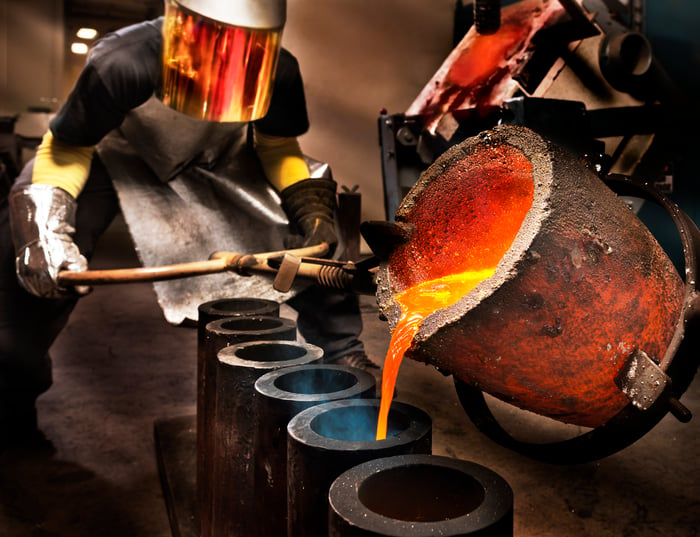Steel is a vital product across many industries, but demand tends to fluctuate along with economic activity. The cyclical nature of demand often leads to huge swings in profitability for steelmakers. But some steel mills are better able to handle the ups and downs than others, and Steel Dynamics (STLD 0.76%) has a proven history of outperforming its peers on one key industry benchmark.
Big and costly
Steel mills are very large, and it requires a lot of money to keep one up and running. That statement is bigger than it seems because running a mill that is producing much less than it can costs just as much as running the same mill at full production levels.
The key difference is the amount of money that is made selling the steel that gets produced. If you only make a small amount of steel you only make a little money to offset the cost of running the mill. In fact, it isn't unusual for steel companies facing low demand to bleed red ink. Commodity prices can impact this dynamic, but usually even high prices don't completely offset the pain of low production rates. And, sometimes, low demand and low prices go hand in hand, augmenting the pain.

Image source: Getty Images.
This is particularly true of blast furnaces, the technology historically used to make steel. When these mills aren't running at high utilization rates they tend to be very unprofitable. Electric arc mini-mills, which are what Steel Dynamics owns, are smaller and more flexible, so they can often be profitable even in low-demand environments. However, profit margins still go down as utilization rates go down.
It might help to put some numbers on this. United States Steel (X 0.67%), which operates both blast furnaces and mini-mills, estimates that its newer mini-mills cost half as much as its legacy blast furnaces to keep up and running. That's a very clear advantage for mini-mills.
From a big-picture standpoint, all of this highlights why the steel industry is so intently focused on utilization rates -- basically, production relative to capacity -- and why Steel Dynamics shines so brightly within the industry.
A history of success
Here are some more numbers to help explain what's going on. In the first quarter of 2023, the U.S. steel industry utilization rate was around 75%. For comparison, in pandemic-hit 2020, when business activity fell sharply as economies around the world effectively shut down to slow the spread of the coronavirus, utilization was around 68%. That said, in 2021, when economies started to open up, utilization was 81%. In other words, 75% isn't exactly a sign of the industry running "hot," but it isn't bad, either.
In the first quarter of 2023, Steel Dynamics' utilization rate was 94%. That is way, way above the average, and it sets the company apart from the pack. But what about at the recent low point in 2020? During that period Steel Dynamics' utilization was 86%, not as good as it was in the first quarter but still far above the average. And in 2021 the company's utilization rate was 95%, just slightly better than in 2023's first quarter. These aren't cherry-picked numbers; the steelmakers' utilization rate has been notably above the average for many years.
A consistently high utilization rate is a good thing, but it also means there's less room for improvement. The steel industry is cyclical and industry upturns can lead to big profits at steel mills. The mills that have room to produce a lot more steel are likely to benefit more from upturns. You can see that in the chart above comparing Steel Dynamics' stock price performance to that of United States Steel, which, as noted, makes much greater use of blast furnaces.
When the steel industry started to pick up again in 2021, investors flocked to U.S. Steel to benefit from the greater opportunity for business recovery. And yet, Steel Dynamics' production strength through the cycle has clearly shown itself -- investors moved on from U.S. Steel as soon as the story changed and utilization rates fell from their 2021 peak.
A sustainable advantage
There are two big-picture ways to look at the steel sector. The first is to see it as a short-term trade as investors look to take advantage of good times. That is, effectively, what buying U.S. Steel in 2021 was. The other is to buy a top industry performer and hold on to it as it expands its business over time. That's the long-term story behind Steel Dynamics, which has high enough utilization rates that it is still building new plants to meet all of the demand it sees. Most investors will probably be better off sticking to a name like Steel Dynamics rather than trying to time the steel industry's cyclical ups and downs.






